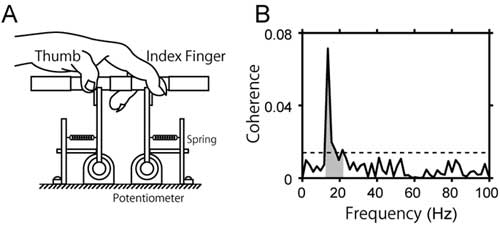We recorded local field potentials (LFPs) from cervical spinal cord (C5-C8) in monkeys performing a precision grip task, and examined their coherence with electromyographic activities (EMGs) (spinomuscular coherence) recorded from hand and arm muscles. Among 164 LFP-EMG pairs, significant coherence was found in 34 pairs (21%). We classified the coherence into two groups based on its frequency range, narrowband coherence and broadband coherence. The narrowband coherence was restricted to discrete frequencies in the range of 14-55 Hz and was widespread throughout the superficial and deep gray matter. In contrast, the broadband coherence distributed between 10-95 Hz and was found only in the ventral half of the spinal cord. The narrowband coherence suggests that oscillations, which have been described in many motor control areas of the brain, could also pass though spinal interneurons to affect motor output and sensorimotor integration. On the other hand, the broadband coherence could be a unique feature of spinal motoneuron — muscle physiology.
Tomohiko Takei1,2,3, Kazuhiko Seki.1,4* Spinomuscular coherence in monkeys performing a precision grip task. J Neurophysiol (January 30, 2008). doi:10.1152/jn.01181.2007
*Corresponding author

Local field potentials (LFPs) of cervical spinal cord and myoelectrical signals (EMGs) of forelimb muscles were recorded from two Japanese monkeys trained to perform precision grip task (A). Significant coherence between LFPs and EMGs (spinomuscular coherence) were found (B, shaded area). Spinomuscular coherence may reflect the intraspinal process of sensorimotor integration for regulating volitional movements.